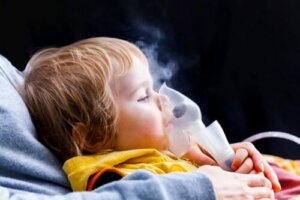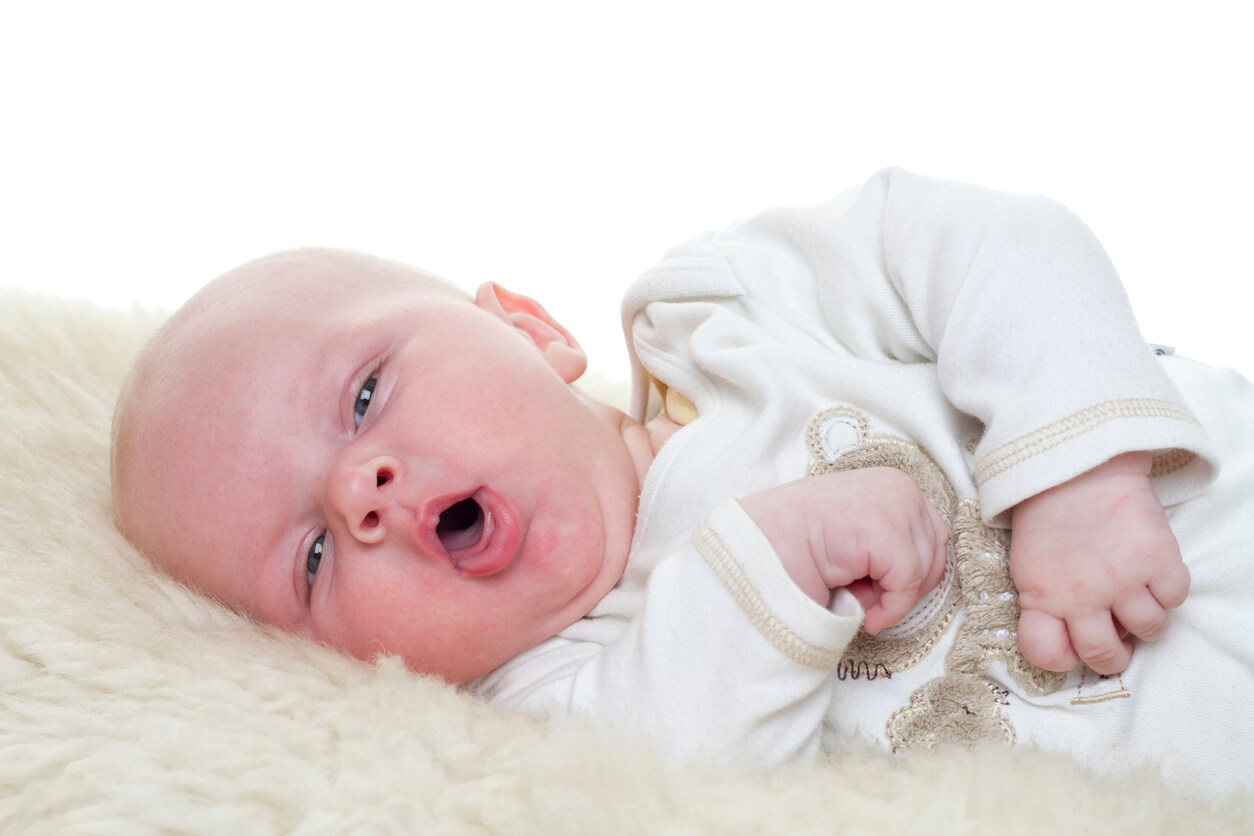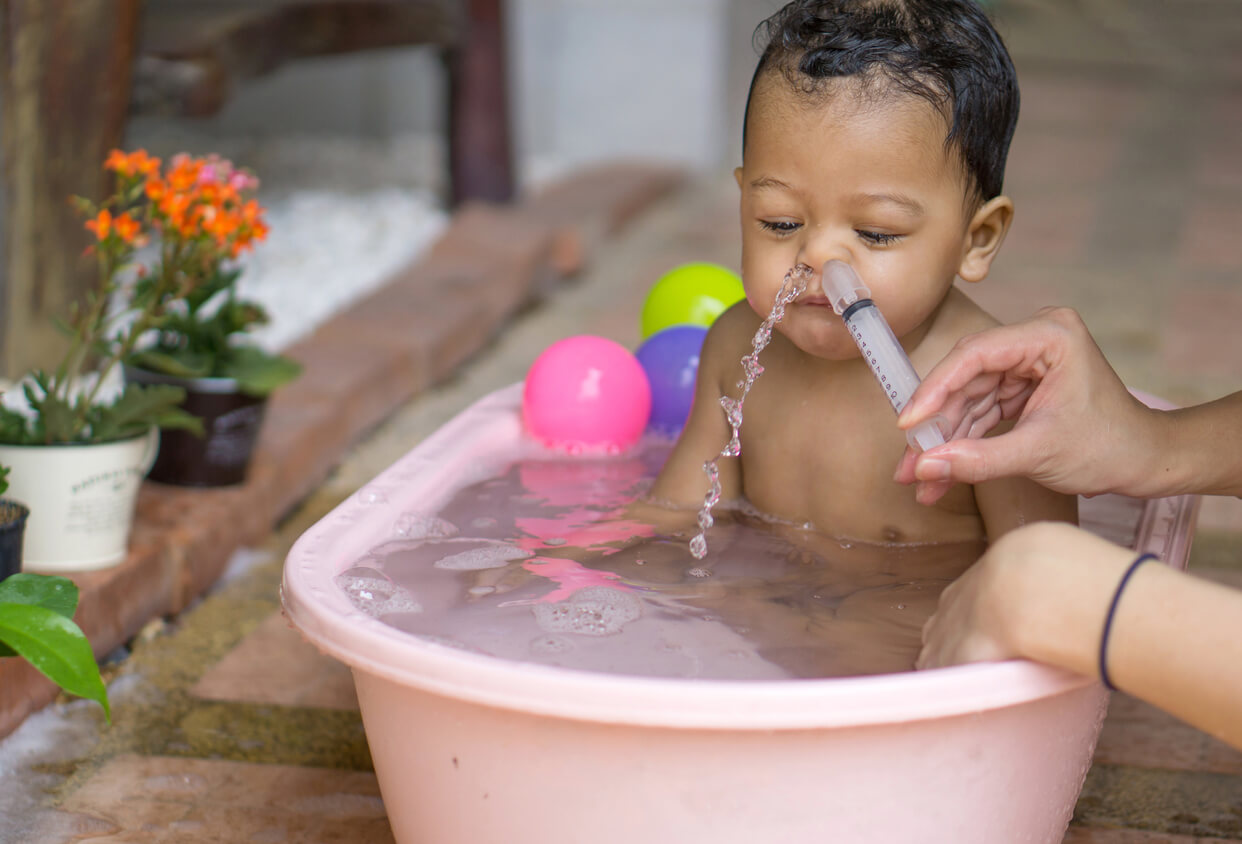Bronchiolitis in Infants: What You Should Know

One of the most common illnesses in infants is bronchiolitis, a respiratory tract condition typical of the cold months of the year
It usually results from a viral infection that causes congestion and inflammation of the narrower airways, called bronchioles. The highest incidence occurs in young infants, between 3 and 6 months of age, due to the immaturity of their immune system.
Most little ones overcome this condition without major inconveniences. However, specialists estimate that acute viral bronchiolitis is one of the main causes of hospitalization in pediatrics. Especially in small babies.
Here, we’re going to tell you more about it and how you can prevent its complications. Keep reading!
What is bronchiolitis?
As we said before, bronchiolitis is the inflammation of the bronchioles, which are the smallest branches of the lungs.
Although it’s an inflammation, most of the time, it’s produced by a viral infection. These agents are transmitted to the infant by airborne particles that the infant breathes or by direct contact with the saliva or mucus of an infected person. In general, from their older siblings or from their classmates at daycare.
Bronchiolitis begins with symptoms of the common cold and after 2 or 3 days, adds “lower” respiratory symptoms, such as cough and difficulty breathing (dyspnea).
This phenomenon occurs in infants because their narrow airways are much more easily obstructed by the slightest inflammation. Therefore, the younger the age or when there’s some conditioning factor, the greater the chances of developing this disease.

Causes of bronchiolitis
Viral infections are the main cause of bronchiolitis in infants. While there are several likely agents, respiratory syncytial virus (RSV) is the leading agent in most cases. However, influenza, parainfluenza, rhinovirus, adenovirus, bocavirus, and metapneumovirus can also cause it.
In addition to viruses, bronchiolitis can be triggered by other entities that promote airway inflammation, such as allergies.
Symptoms of bronchiolitis in infants
At first, bronchiolitis symptoms are similar to those of a common cold:
- Nasal congestion
- Catarrhal cough
- Fever
- Increased nasal secretions
- Loss of appetite
- Fatigue and tiredness
But after a few days, the symptoms characteristic of the entity begin to appear, alerting us to the possibility of inflammation in the “lower” airway or inside the lungs:
- Difficulty breathing (dyspnea). The baby breathes sharply even at rest and uses all the muscles of the chest, neck, and abdomen to draw air into the lungs. This is evidenced by sinking into the hollows between the ribs, exaggerated abdominal movements, and even forward pitching, which coincides with exhalation.
- Expiratory wheezing. These are high-pitched whistling or whimpering sounds when the baby exhales. This indicates a small airway obstruction. Sometimes they can be heard without using a stethoscope.
- Problems with resting, feeding, and hydration.
- Irritability or pronounced tendency to sleep.
- In advanced cases, cyanosis of the face or lips, which is the bluish coloration of the skin due to lack of oxygen, may be observed.
Faced with these symptoms, it’s essential to go immediately to the hospital, as the child requires urgent evaluation.
It’s possible that in addition to the physical examination, the doctor may indicate some complementary tests, such as a chest X-ray and a blood test. This is in order to differentiate bronchiolitis from other common pulmonary alterations of this stage and thus indicate the appropriate treatment.
What’s the difference between bronchiolitis and bronchitis?
Bronchiolitis is a condition of the thinner branches of the bronchi, which only occurs in infants or children under 2 years of age. In fact, this is the name given to the first broncho-obstructive episode in infants. The successive ones are called bronchial spasms or bronchospasms.
Bronchitis, on the other hand, affects the thicker branches of the pulmonary tree, called bronchi. These don’t usually cause the same symptoms as bronchiolitis, but are limited to a cough with phlegm and fever.
Treatment of bronchiolitis in infants
Treatment of bronchiolitis depends on the course of the disease. In most cases, the condition does not require hospitalization and is managed with supportive measures at home. Below, we share them with you:
- Avoid nasal obstruction. Perform nasal lavage with physiological solution to dilute the mucus and then aspirate manually or with an electric aspirator. Although it doesn’t resolve the obstruction of the lower airway, it improves the possibility of oxygenated air entering the lungs.
- Elevate the baby’s headboard while sleeping. This avoids upper airway obstructions caused by the baby’s tongue and the accumulation of secretions in the pharynx.
- Use a vaporizer or humidifier in the room. This recommendation will depend on the context, as it will only benefit the child if the climate is extremely dry. In other cases, and especially in young babies, it may be better to avoid it.
- Hydrate the baby frequently. Y0u must offer liquids constantly, within what’s usually ingested (milk, water, fruit juices, broths). Remember that babies under 6 months of age should only drink breast milk or their regular formula. With fussiness and snot, babies lose much more water than usual. Therefore, it’s key to replenish as much as possible to avoid dehydration.
- If they have difficulty suckling or feeding, offer short, repeated feedings.
The pediatrician may prescribe pediatric Tylenol to calm general malaise and fever, in case it appears.
If the bronchiolitis worsens, the specialist will evaluate the need to admit the child. In these cases, treatment with oxygen, intravenous hydration and the administration of medication, when necessary, will most likely be required.

How to prevent bronchiolitis in infants?
Every winter, it’s important to implement all the hygiene measures to prevent respiratory infections at home. Although they can be mild in adults, in children and babies, they can be very serious. Therefore, take into account the following preventive measures:
- Ensure proper handwashing upon returning home and before contact with your baby.
- Avoid contact with sick people or those with a cold.
- Breastfeed your baby as much as you can. This way, you provide extra protection against respiratory infections.
- Keep your baby’s surfaces clean and disinfected, as well as your home well ventilated.
Bronchiolitis is a pulmonary alteration that limits itself and is usually managed at home, however, in some cases, it requires hospitalization. Especially in premature babies, babies younger than 6 months, or those with chronic diseases.
In addition, it should be noted that many children who suffer from RSV bronchiolitis may develop asthma in the future, but this doesn’t occur in all cases. Some studies suggest that the sequelae caused by this virus could act as inducers or facilitators of the development of asthmatic disease.
So, when the first cold weather arrives, put into practice all the preventive measures mentioned above and consult your pediatrician if you have any doubts about your baby’s symptoms. Timely and appropriate treatment can change the prognosis of the disease.
One of the most common illnesses in infants is bronchiolitis, a respiratory tract condition typical of the cold months of the year
It usually results from a viral infection that causes congestion and inflammation of the narrower airways, called bronchioles. The highest incidence occurs in young infants, between 3 and 6 months of age, due to the immaturity of their immune system.
Most little ones overcome this condition without major inconveniences. However, specialists estimate that acute viral bronchiolitis is one of the main causes of hospitalization in pediatrics. Especially in small babies.
Here, we’re going to tell you more about it and how you can prevent its complications. Keep reading!
What is bronchiolitis?
As we said before, bronchiolitis is the inflammation of the bronchioles, which are the smallest branches of the lungs.
Although it’s an inflammation, most of the time, it’s produced by a viral infection. These agents are transmitted to the infant by airborne particles that the infant breathes or by direct contact with the saliva or mucus of an infected person. In general, from their older siblings or from their classmates at daycare.
Bronchiolitis begins with symptoms of the common cold and after 2 or 3 days, adds “lower” respiratory symptoms, such as cough and difficulty breathing (dyspnea).
This phenomenon occurs in infants because their narrow airways are much more easily obstructed by the slightest inflammation. Therefore, the younger the age or when there’s some conditioning factor, the greater the chances of developing this disease.

Causes of bronchiolitis
Viral infections are the main cause of bronchiolitis in infants. While there are several likely agents, respiratory syncytial virus (RSV) is the leading agent in most cases. However, influenza, parainfluenza, rhinovirus, adenovirus, bocavirus, and metapneumovirus can also cause it.
In addition to viruses, bronchiolitis can be triggered by other entities that promote airway inflammation, such as allergies.
Symptoms of bronchiolitis in infants
At first, bronchiolitis symptoms are similar to those of a common cold:
- Nasal congestion
- Catarrhal cough
- Fever
- Increased nasal secretions
- Loss of appetite
- Fatigue and tiredness
But after a few days, the symptoms characteristic of the entity begin to appear, alerting us to the possibility of inflammation in the “lower” airway or inside the lungs:
- Difficulty breathing (dyspnea). The baby breathes sharply even at rest and uses all the muscles of the chest, neck, and abdomen to draw air into the lungs. This is evidenced by sinking into the hollows between the ribs, exaggerated abdominal movements, and even forward pitching, which coincides with exhalation.
- Expiratory wheezing. These are high-pitched whistling or whimpering sounds when the baby exhales. This indicates a small airway obstruction. Sometimes they can be heard without using a stethoscope.
- Problems with resting, feeding, and hydration.
- Irritability or pronounced tendency to sleep.
- In advanced cases, cyanosis of the face or lips, which is the bluish coloration of the skin due to lack of oxygen, may be observed.
Faced with these symptoms, it’s essential to go immediately to the hospital, as the child requires urgent evaluation.
It’s possible that in addition to the physical examination, the doctor may indicate some complementary tests, such as a chest X-ray and a blood test. This is in order to differentiate bronchiolitis from other common pulmonary alterations of this stage and thus indicate the appropriate treatment.
What’s the difference between bronchiolitis and bronchitis?
Bronchiolitis is a condition of the thinner branches of the bronchi, which only occurs in infants or children under 2 years of age. In fact, this is the name given to the first broncho-obstructive episode in infants. The successive ones are called bronchial spasms or bronchospasms.
Bronchitis, on the other hand, affects the thicker branches of the pulmonary tree, called bronchi. These don’t usually cause the same symptoms as bronchiolitis, but are limited to a cough with phlegm and fever.
Treatment of bronchiolitis in infants
Treatment of bronchiolitis depends on the course of the disease. In most cases, the condition does not require hospitalization and is managed with supportive measures at home. Below, we share them with you:
- Avoid nasal obstruction. Perform nasal lavage with physiological solution to dilute the mucus and then aspirate manually or with an electric aspirator. Although it doesn’t resolve the obstruction of the lower airway, it improves the possibility of oxygenated air entering the lungs.
- Elevate the baby’s headboard while sleeping. This avoids upper airway obstructions caused by the baby’s tongue and the accumulation of secretions in the pharynx.
- Use a vaporizer or humidifier in the room. This recommendation will depend on the context, as it will only benefit the child if the climate is extremely dry. In other cases, and especially in young babies, it may be better to avoid it.
- Hydrate the baby frequently. Y0u must offer liquids constantly, within what’s usually ingested (milk, water, fruit juices, broths). Remember that babies under 6 months of age should only drink breast milk or their regular formula. With fussiness and snot, babies lose much more water than usual. Therefore, it’s key to replenish as much as possible to avoid dehydration.
- If they have difficulty suckling or feeding, offer short, repeated feedings.
The pediatrician may prescribe pediatric Tylenol to calm general malaise and fever, in case it appears.
If the bronchiolitis worsens, the specialist will evaluate the need to admit the child. In these cases, treatment with oxygen, intravenous hydration and the administration of medication, when necessary, will most likely be required.

How to prevent bronchiolitis in infants?
Every winter, it’s important to implement all the hygiene measures to prevent respiratory infections at home. Although they can be mild in adults, in children and babies, they can be very serious. Therefore, take into account the following preventive measures:
- Ensure proper handwashing upon returning home and before contact with your baby.
- Avoid contact with sick people or those with a cold.
- Breastfeed your baby as much as you can. This way, you provide extra protection against respiratory infections.
- Keep your baby’s surfaces clean and disinfected, as well as your home well ventilated.
Bronchiolitis is a pulmonary alteration that limits itself and is usually managed at home, however, in some cases, it requires hospitalization. Especially in premature babies, babies younger than 6 months, or those with chronic diseases.
In addition, it should be noted that many children who suffer from RSV bronchiolitis may develop asthma in the future, but this doesn’t occur in all cases. Some studies suggest that the sequelae caused by this virus could act as inducers or facilitators of the development of asthmatic disease.
So, when the first cold weather arrives, put into practice all the preventive measures mentioned above and consult your pediatrician if you have any doubts about your baby’s symptoms. Timely and appropriate treatment can change the prognosis of the disease.
All cited sources were thoroughly reviewed by our team to ensure their quality, reliability, currency, and validity. The bibliography of this article was considered reliable and of academic or scientific accuracy.
- Baquero R. (2009). Guía práctica clínica: bronquiolitis. Salud Uninorte. Barranquilla (Col.) 2009; 25, (1): 135-149.
- Benito, J. (2020). Diagnóstico y tratamiento de la bronquiolitis aguda en Urgencias. Protoc diagn ter pediatr. 2020;1:63-73
- Castaños, C. (2019). GAP 2013: Manejo de la Bronquiolitis. Actualización 2019. Coordinación de Evaluación de Tecnología Sanitaria
- García, M. (2017). Bronquiolitis aguda viral. Asociación Española de Pediatría. . Protocolos diagnósticos ter pediatría. 2017;1:85-102
- Pérez, J. (2016). Bronquitis y bronquiolitis. Pediatría Integral 2016; XX (1): 28–37.
This text is provided for informational purposes only and does not replace consultation with a professional. If in doubt, consult your specialist.








